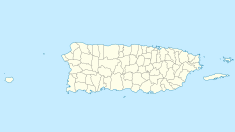| Revision as of 19:46, 18 December 2024 editEljohnson15 (talk | contribs)Autopatrolled, Extended confirmed users, Pending changes reviewers, Rollbackers7,824 editsNo edit summary← Previous edit | Latest revision as of 06:45, 2 January 2025 edit undoThe Eloquent Peasant (talk | contribs)Extended confirmed users, Pending changes reviewers155,599 edits →History: fixed typoTags: Mobile edit Mobile web edit | ||
| (14 intermediate revisions by 5 users not shown) | |||
| Line 1: | Line 1: | ||
| {{short description|Historic house in Mayagüez, Puerto Rico}} | {{short description|Historic house in Mayagüez, Puerto Rico}}{{Infobox historic site | ||
| {{Infobox historic site | |||
| | name = Tienda-Almacén Siempreviva | | name = Tienda-Almacén Siempreviva | ||
| | other_name = Casa Sigma Mayagüez | | other_name = Casa Sigma Mayagüez | ||
| Line 19: | Line 17: | ||
| }} | }} | ||
| '''Tienda-Almacén Siempreviva''' |
'''Tienda-Almacén Siempreviva''', later '''Casa Sigma Mayagüez,''' is a historic building located in ]. | ||
| == History == | |||
| It was built at the beginning of the nineteenth century in neoclassical Creole style. it is a representative example of a ground floor masonry building for residential use. The property is part of a group of structures said to have been built to house Spanish officers. The houses are located on what became Ernesto Ramos Antonini Street. They were built during the last quarter of the nineteenth century. Their construction followed the rules established for the rebuilding of Villa de Mayagüez, following the Great Fire of 1841. The rules dictated plot size, height, construction materials, and perimeter walls (height and materials), and specified the use of a document outlining approved facade designs. | |||
| The lots were distributed giving the owners a term of four to six months for construction. It was forbidden to add a wooden roof, to prevent future fires from spreading easily. These rules marked a transformation and evolution in the urban fabric and architecture of Mayagüez. Most likely because of those rules its architecture has the highest interiors on the island.<ref>{{cite book |last=Alvarez Cervela |first=José M. |title=La Arquitectura Clásica Actual en Mayagüez |publisher=Antillian College Press |date=1983 |location=Mayagüez, Puerto Rico |pages=21 |language=Spanish |jfm=}}</ref> | |||
| The structure operated for many years as the warehouse for |
The structure operated for many years as the warehouse for {{lang|es|La Siempreviva}} fabric store. In 2004, and after the store closed, the building was designated as a historical building and inducted into the ] by the ].<ref>{{Cite web |author=Junta de Planificación de Puerto Rico |date=December 7, 2022 |title=Registro de propiedades designadas por la Junta de Planificación de Puerto Rico |url=https://jp.pr.gov/wp-content/uploads/2022/12/REGISTRO-OFICIAL-DE-SITIOS-Y-ZONAS-HISTORICAS-DESIGNADAS-Rev.-DIC-2022.pdf |website=jp.pr.gov}}</ref> In 2022, after many years in disrepair, it was purchased and work began on its reconstruction. It is intended to serve as the gathering space for the ] fraternity.<ref>{{Citation| title = Casa Sigma Mayagüez| newspaper = Anuario Sigma| pages = 69| date = October 2023| url = https://www.phisigmaalpha.org/convencion-2023/| language = Spanish| access-date = December 18, 2024}}</ref> | ||
| ==See also== | |||
| {{Portal|Puerto Rico}} | {{Portal|Puerto Rico}} | ||
| Line 34: | Line 34: | ||
| ] | ] | ||
| ] | ] | ||
| ] | |||
| {{PuertoRico-struct-stub}} | |||
| ] | |||
Latest revision as of 06:45, 2 January 2025
Historic house in Mayagüez, Puerto Rico| Tienda-Almacén Siempreviva | |
|---|---|
| Casa Sigma Mayagüez | |
 | |
| Location | Barrio Pueblo, 20 Pablo Casals Street, Mayagüez, Puerto Rico |
| Coordinates | 18°12′03.07″N 67°08′35.37″W / 18.2008528°N 67.1431583°W / 18.2008528; -67.1431583 |
| Built | early 19th century |
| Restored | 2024 |
| Architectural style(s) | Neoclasic Creole |
| Invalid designation | |
| Designated | December 2, 2004 |
| Reference no. | 2004-29-02-JP-DE |
Tienda-Almacén Siempreviva, later Casa Sigma Mayagüez, is a historic building located in Mayagüez, Puerto Rico.
History
It was built at the beginning of the nineteenth century in neoclassical Creole style. it is a representative example of a ground floor masonry building for residential use. The property is part of a group of structures said to have been built to house Spanish officers. The houses are located on what became Ernesto Ramos Antonini Street. They were built during the last quarter of the nineteenth century. Their construction followed the rules established for the rebuilding of Villa de Mayagüez, following the Great Fire of 1841. The rules dictated plot size, height, construction materials, and perimeter walls (height and materials), and specified the use of a document outlining approved facade designs.
The lots were distributed giving the owners a term of four to six months for construction. It was forbidden to add a wooden roof, to prevent future fires from spreading easily. These rules marked a transformation and evolution in the urban fabric and architecture of Mayagüez. Most likely because of those rules its architecture has the highest interiors on the island.
The structure operated for many years as the warehouse for La Siempreviva fabric store. In 2004, and after the store closed, the building was designated as a historical building and inducted into the Puerto Rico Register of Historic Sites and Zones by the Puerto Rico Planning Board. In 2022, after many years in disrepair, it was purchased and work began on its reconstruction. It is intended to serve as the gathering space for the Phi Sigma Alpha fraternity.
References
- Alvarez Cervela, José M. (1983). La Arquitectura Clásica Actual en Mayagüez (in Spanish). Mayagüez, Puerto Rico: Antillian College Press. p. 21.
- Junta de Planificación de Puerto Rico (December 7, 2022). "Registro de propiedades designadas por la Junta de Planificación de Puerto Rico" (PDF). jp.pr.gov.
- "Casa Sigma Mayagüez", Anuario Sigma (in Spanish), p. 69, October 2023, retrieved December 18, 2024